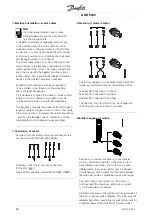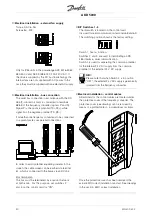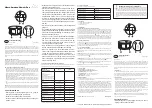
AKD 5000
■
Automatic Motor Adaptation, AMA
Automatic motor adaptation is a test algorithm
that measures the electrical motor parameters at
a motor standstill. This means that AMA itself
does not supply any torque.
AMA is useful when commissioning systems, where
the user wants to optimise the adjustment of the
frequency converter to the motor applied. This feature
is used in particular where the factory setting does
not adequately cover the motor in question.
There are two motor parameters that are of primary
significance in automatic motor adaptation: the
stator resistance, Rs, and the reactance at normal
magnetising level, Xs. Parameter 107 allows a choice
of automatic motor adaptation, with determination
of both Rs and Xs, or reduced automatic motor
adaptation with determination of only Rs.
The duration of a total automatic motor adaptation
varies from a few minutes on small motors to more
than 10 minutes on large motors.
Limitations and preconditions:
•
For AMA to be able to determine the motor
parameters optimally, the correct nameplate data
for the motor connected to the frequency converter
must be entered in parameters 102 to 106.
•
For the best adjustment of the frequency
converter, it is recommended to carry out AMA
on a cold motor. Repeated AMA runs may lead
to a heating of the motor that will result in an
increase of the stator resistance, Rs.
•
AMA can only be carried out if the rated motor
current is minimum 35% of the rated output
current of the frequency converter. AMA can be
carried out up to one oversize motor.
•
If a LC filter is inserted between the frequency
converter and the motor, it will only be possible
to carry out a reduced test. If an overall
setting is required, remove the LC filter while
running a total AMA. After completion of the
AMA reinsert the LC filter.
•
If motors are coupled in parallel only use
reduced AMA if any.
•
When using synchronous motors it is only
possible to make a reduced AMA.
•
Long motor cables can have an effect on the
implementation of the AMA function if their resistance
is bigger than the stator resistance of the motor.
How to perform an AMA
1. Press the [STOP/RESET] key
2. Set motor nameplate data in parameters 102 to 106
3. Select whether a total [ENABLE (RS,XS)]or a reduced
[ENABLE RS] AMA is required in parameter 107
4. Connect terminal 12 (24 VDC) to terminal
27 on the control card
5. Press the [START] key or connect terminal
18 (start) to terminal 12 (24 VDC) to start the
automatic motor adaptation.
Now the automatic motor adaptation goes through
four tests (for reduced AMA only the first two tests).
The different tests can be followed in the display as
dots after the text
WORKING
in parameter 107:
1. Initial error check where nameplate data and physical
errors are checked. Display shows
WORKING.
2. DC test where the stator resistance is estimated.
Display shows
WORKING..
3. Transient test where the leakage inductance is
estimated. Display shows
WORKING...
4. .AC test where the stator reactance is estimated.
Display shows
WORKING....
NB!:
AMA can only be carried out if there are
no alarms during tuning.
Discontinue AMA
If the automatic motor adaptation is to be discontinued,
press the [STOP/RESET] key or disconnect
terminal 18 from terminal 12.
The automatic motor adaptation ends up with one
of the following messages after the test:
Warnings and alarm messages
ALARM 21
Auto-optimisation OK
Press the [STOP/RESET] key or disconnect terminal 18
from terminal 12. This alarm indicates that the AMA is
OK and that the drive is correctly adapted to the motor.
ALARM 22
Auto-optimisation not OK
[AUTO MOTOR ADAPT OK]
A fault has been found during automatic motor
adaptation. Press the [STOP/RESET] key or disconnect
terminal 18 from terminal 12. Check the possible cause
to the fault related to the alarm message given. The
figure after the text is the error code, which can be
seen in the fault log in parameter 615. Automatic motor
adaptation does not update parameters. You may
choose to run a reduced automatic motor adaptation.
MG.50.R3.02 -
52
















































